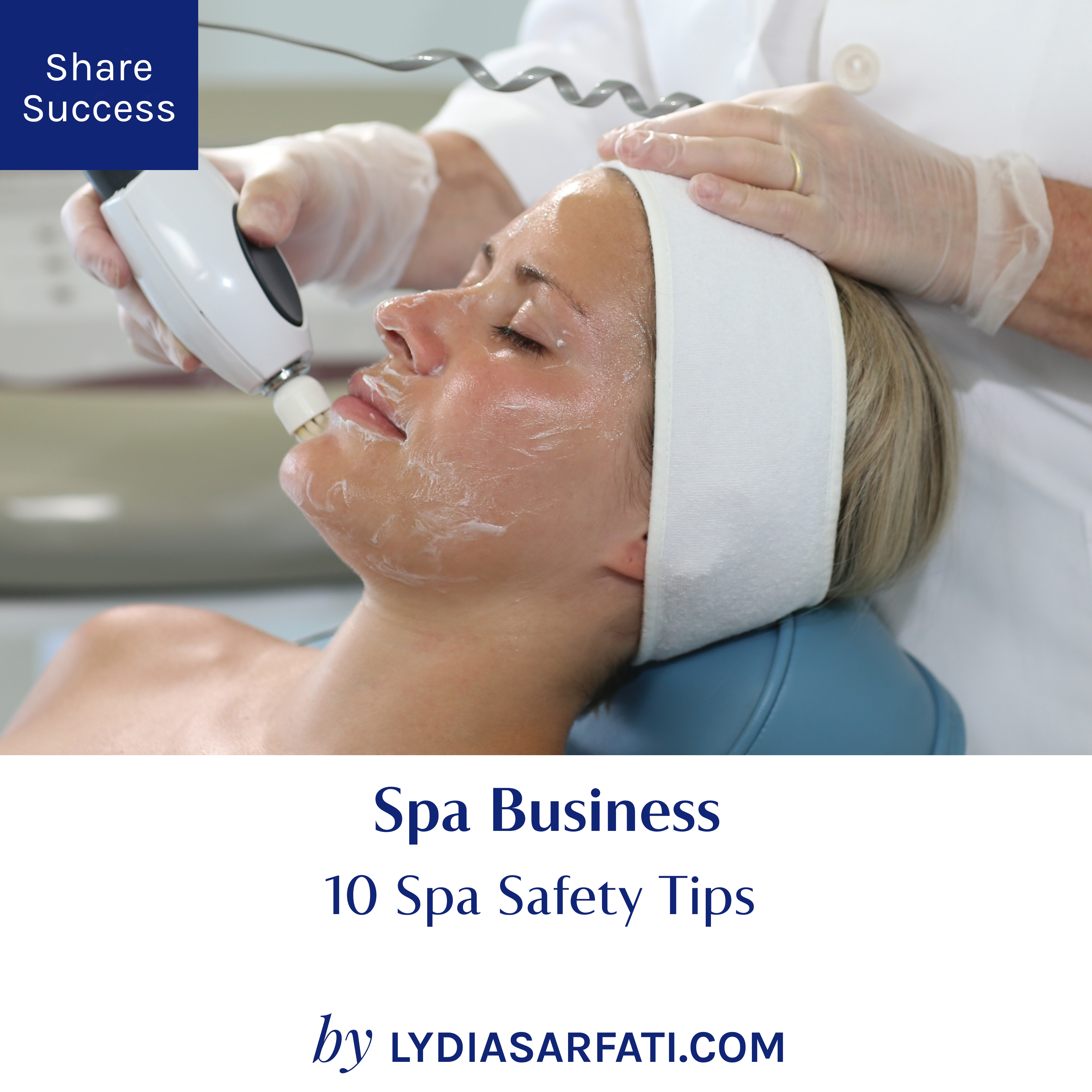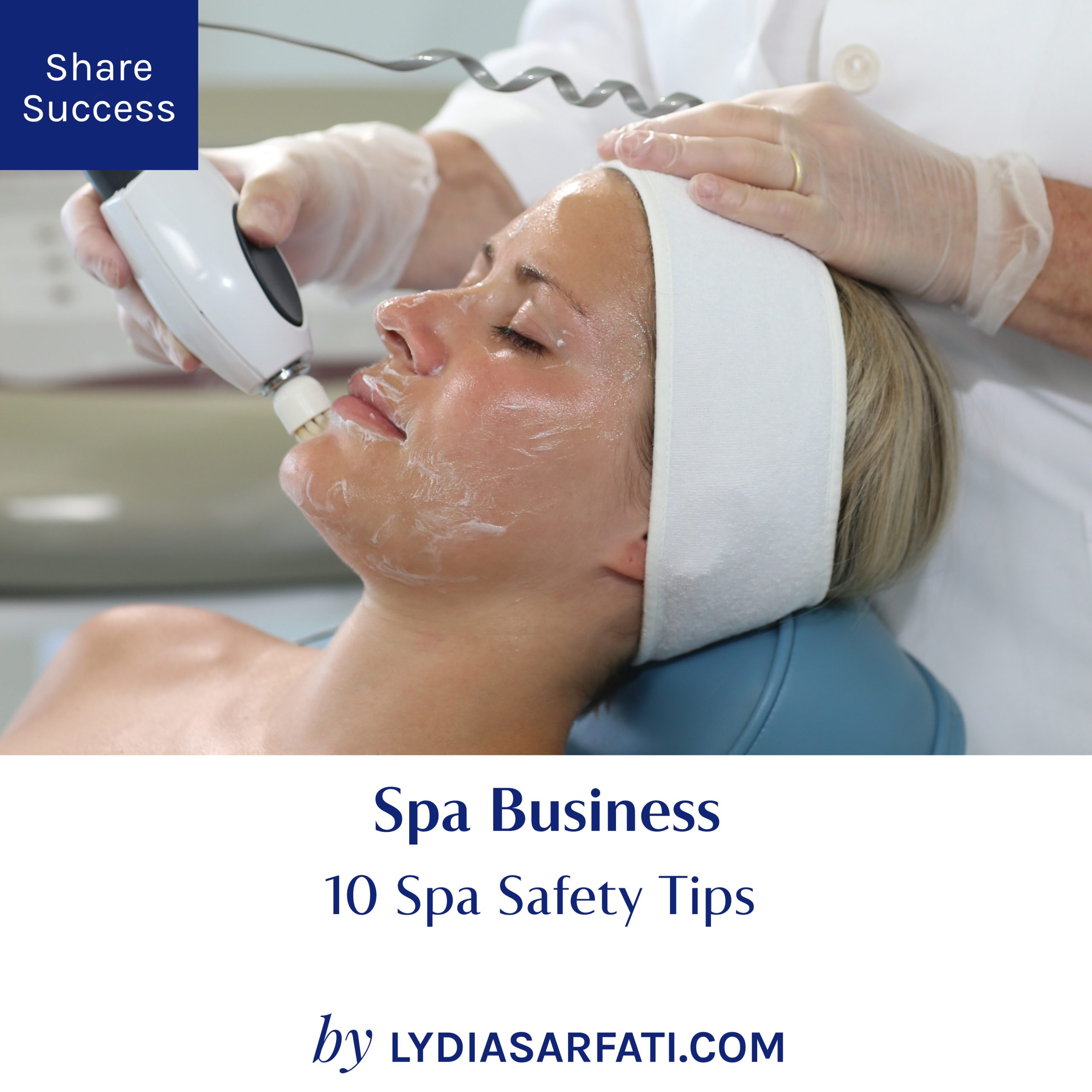
Your clients deserve the very best, and that means a clean and safe environment. Maintaining optimum safety standards when you are running a spa or salon is the most important duty a spa owner and manager must fulfill.
Adhering to state and federal regulations is required by law, and anything less can result in criminal violation. It is also good business.
Here are 10 fast safety tips to consider as your review your spa and salons safety measures.
1. Spa Design
The design of your spa or salon isn’t just about creating a relaxing luxurious environment for your clients and staff — it must be constructed and equipped with safety in mind.
A healthy, ventilated work space will assure a healthy aesthetician and healthy clients.
Whether you are a spa or salon owner, a member of the staff, or a consultant, the following are the most important features to look for in a treatment room or area.
Size: The treatment room or area should be at least 80 square feet (8 X 10) to insure proper movement of the aesthetician in the space. Neither the professional nor the client should ever feel cramped.
Proper Ventilation: The Occupational Safety and Health Administration or OSHA provides important guidelines for ventilation in regards to nail service rooms or areas, as well as use of formaldehydes in hair care, but proper ventilation is also key for the health of the skin care practitioner as well as the client.
- Fumes from skin care treatments, as well as cleaning and disinfectant materials must be properly eliminated.
- Air vents must be present in the room, providing both input and output of air. This means two separate vents.
- Vents must be properly functioning and calibrated for two or more people within the room.
Electrical Outlets: With the use of more and more electrical machines as well as computers within the treatment room, the proper amount of electrical outlets, with subsequent appropriate electrical service capability, is essential to the proper functioning of the treatment room or area.
- Treatment rooms should have a minimum of four separate electrical outlets.
- Do not use extension cords or multiple plug appliances, as these can overheat and become a fire hazard.
- Be sure that all wires are not in either your way or in the way of the client.
2. Ergonomics
The room setup should be comfortable for the technician to avoid strain on the hands, body, and back.
Facial tables and stools:
- Adjust the facial table height, if possible.
- When setting up, remember to align the stool with the facial table for the correct height and position for performing services.
- The technician’s feet should be flat on the floor, and hands should be below chest level.
Arrange the supply cart or counter as close to the facial table as possible.
3. Disinfection vs. Sterilization
Disinfection is the treatment of a surface to destroy potentially disease-causing micro-organisms. Sterilization is the process that destroys all microbial life.
A wet EPA-registered disinfectant must be located in each treatment room for disinfecting tools and equipment and all implements must be thoroughly cleaned before being placed in this disinfectant solution. It’s important to note that an ultraviolet (UV) sanitizer unit does not disinfect tools and is only used for storage.
4. Disinfecting Equipment and the Treatment Room
Guidelines for proper disinfection, cleaning and sanitation should be posted in several areas of your salon and spa.
Keep a protocol of proper procedure in each room and clean and disinfect after each use using the following procedure using a state regulated disinfectant or 70% isopropyl alcohol solution. Also, change the high-level disinfectant solution in the container according manufacturer’s directions.
Disinfection Checklist:
- Properly dispose of used supplies in closed lid trash can.
- Turn off the table warmer if used.
- Clean the wax machine and turn it off and unplug at the end of the day.
- Disinfect the steamer and magnifying lamp.
- Disinfect the bottom tray and the inside of the towel warmer after removing all used items.
- Disinfect any other equipment used, and turn it off.
- Clean all containers, and wipe off dirty product containers with a disinfectant.
- Clean all counters, sinks, surfaces and floor mats with disinfectant.
5. Gloves and Hand Washing
OSHA requires that gloves be worn when there is a reasonable likelihood that hands will be in contact with blood, mucous, non-intact skin (such as open acne lesions) possibly contaminated items or contaminated surfaces.
Gloves
Should be properly put on and worn during treatments and during cleaning and disinfection, removed properly, discarded in a closed receptacle and followed by a thorough hand washing.
What to look for in proper gloves:
- Proper fit. If too loose, you will not be able to perform the facial or body procedures correctly.
- Proper material. Because of the increase in latex sensitivities both in the esthetician and client, opt for vinyl gloves.
- Non-powdered. Studies show that powdered gloves actually absorb the infectious microorganisms rather than block or repel them.
Hand washing
Frequent proper hand washing is the first and most essential preventative measure to control and prevent the transmission of germs.
Wash your hands in antibacterial soap for sixty second before and after every client contact.
6. Disposal of Potentially Infected Material
OSHA regulates proper disposal of any item containing blood or other bodily fluids as well as sharp objects such as lancets.
Be aware of your state regulations as well, as some states do not allow lancets to be used during facials.
If lancets are permissible, they must be disposed of after every use in a specific disposal unit called a sharps box.
Other items such as cotton or swabs must be disposed of in a biohazard container if they have been in contact with blood or other bodily fluid or material.
7. Use and Proper Cleaning of Autoclave for Sterilization
An autoclave is a sterilizer for implements that completely kills all microorganism including bacteria, fungi, viruses and bacterial spores.
An autoclave sterilizes by providing pressurized steam. All reusable implements need to be sterilized in between treatments. If you do not have a sterilizer or autoclave, you should not use re-useable implements.
Proper cleaning, maintenance and testing of your sterilizer are important to assure proper sterilization and fulfil state regulations. Some states require a weekly testing with state regulated materials.
**Check with your state boards to ascertain what is required.
Follow your sterilizer’s manufacturers’ guidelines for daily, weekly and monthly cleaning and maintenance to assure the machine is working at optimal level.
Lack of maintenance can cause high and frequent repair costs. A lack of maintenance will also lead to deterioration and excessive wear of the contents being sterilized.
8. Use Disposables
Using disposable items is the best way to ensure proper hygiene. Single-use items are disposable and can only be used once. This supply usage depends on your facility and may include the following:
- Paper towels.
- Client headband to protect the hair and hold it out of the way.
- Personal Service Towels to drape clients and to keep work area clean.
- Sterile cotton 4″ × 4″ pads or single-use sponges to remove product from the skin.
- Sterile gauze squares for use with certain facial treatments.
- Sterile cotton pads for cleaning and for product application.
- Medical grade tissues that do not contain fragrance or dyes for blotting the face.
- Sterile cotton swabs for performing extractions. These can have wooden handles for extra strength.
- Makeup sponges for applying makeup post procedure and for applying produce.
- Disposable vinyl or nitrile gloves.
- A sealable plastic bag for proper disposal of single-use items (not sure if needed).
- Lancets see state regulations for extraction rules).
Appropriate handling of single-use items involves the following:
- Soiled items such as gloves and extraction supplies must be placed in a covered waste container.
- While in use, single-use items must be placed on surfaces that can be disinfected or disposed of, such as a paper towel.
- Disposable extraction lancets go in a biohazard/sharps container.
9. SDS Sheets
Safety data sheets, or SDS, are informational forms regarding every skin care product, both retail and professional, used in the salon which includes the product name, product code, ingredients, relevant use of substance (cosmetic/skincare), restrictions on use (for example: on skin as directed on product label) and details of supplier of product and address, emergency contact information, such as a phone number of the manufacturer.
SDS sheets also give details such as the identification of any hazardous substances, precautionary statements, first aid measures, accidental release measures, proper handling and storage.
SDS sheets should be kept in a binder or on the computer within the treatment room for easy access in case they are needed. Although skin care ingredients are fairly innocuous, standard procedure requires these sheets also provide information on exposure control, physical and chemical properties, stability and reactivity and toxicological, ecological, disposal and regulatory information, both national and international.
10. Waxing Procedures
Proper hygiene is extremely important during waxing. Skin is more susceptible to infection during waxing as the hair is removed and the follicles are opened.
With waxing, the following protocol should always be implemented:
- Wash hands before and after each client. Use liquid anti-bacterial soap for at least 10 to 15 seconds.
- Use gloves to ensure your safety and the safety of the client. Use non-latex versions and make sure they properly fit.
- It goes without saying, but must be said again. NO DOUBLE DIPPING!
- All non-disposable instruments must be sterilized in a sterilizer or autoclave before and after treatments. This includes metal spatulas, tweezers and body brushes.
- Disposable items must be kept in a closed environment near the waxing station.
- Each treatment requires a fresh disposable sheet, towel and paper covering.
- Clean and dust the treatment room each evening before going home.
- Remove all wax residue from the floor, trolley and pot.
Remember:
- Wax won’t kill bacteria — Although the wax pot is getting warmed and liquefied in a heater, the temperature is not to the degree which will kills germs and bacteria. Proper temperature to kill all bacteria is 100 degrees Celsius or 212 degrees Fahrenheit, far too hot to apply to the skin without burning.
- You must keep a sanitary environment and instruments — Federal law states that “everyone should be considered as contaminated and that service providers who are occupationally exposed or have potential to be are required to use preventative measure to prevent cross contamination (For more details visit OSHA)
Read more about sanitary waxing.
SPA SAFETY RESOURCES:
**For worker safety regulations, visit The United States Department of Labor Occupational Safety and Health Administration (OSHA): https://www.osha.gov/law-regs.html.
**Check with your state cosmetology board for the most up-to-date information on proper cleansing and disinfection of your establishment.
***For proper cleaning and sterilization procedures and disposal of materials, visit the Environmental Protection Agency (EPA): https://www.epa.gov/.
This blog is for informational purposes only and is not intended as medical advice, treatment or diagnosis.
